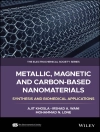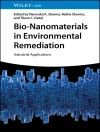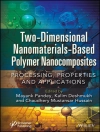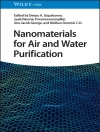An invaluable introduction to nanomaterials and their
applications
Offering the unique approach of applying traditional physics
concepts to explain new phenomena, Introduction to Nanomaterials
and Devices provides readers with a solid foundation on the subject
of quantum mechanics and introduces the basic concepts of
nanomaterials and the devices fabricated from them. Discussion
begins with the basis for understanding the basic properties of
semiconductors and gradually evolves to cover quantum
structures–including single, multiple, and quantum
wells–and the properties of nanomaterial systems, such as
quantum wires and dots.
Written by a renowned specialist in the field, this book
features:
* An introduction to the growth of bulk semiconductors,
semiconductor thin films, and semiconductor nanomaterials
* Information on the application of quantum mechanics to
nanomaterial structures and quantum transport
* Extensive coverage of Maxwell-Boltzmann, Fermi-Dirac, and
Bose-Einstein stastistics
* An in-depth look at optical, electrical, and transport
properties
* Coverage of electronic devices and optoelectronic devices
* Calculations of the energy levels in periodic potentials,
quantum wells, and quantum dots
Introduction to Nanomaterials and Devices provides essential
groundwork for understanding the behavior and growth of
nanomaterials and is a valuable resource for students and
practitioners in a field full of possibilities for innovation and
invention.
विषयसूची
Chapter One. Growth of bulk, thin films, and nanomaterials.
1.1 Introduction.
1.2 Growth of bulk semiconductors.
1.3 Growth of semiconductor thin films.
1.4 Fabrication and growth of semiconductor nanomaterials.
1.5 Colloidal Growth of nanocrystals.
Chapter Two. Application of quantum mechanics to nanomaterial structures.
2.1 Introduction.
2.2 The de Broglie Relation.
2.3 Wave functions and Schrödinger Equation.
2.4 Dirac Notation.
2.5 Variational method.
2.6 Stationary states of a particle in a potential step.
2.7 Potential barrier with a finite height.
2.8 Potential well with an infinite depth.
2.9 Finite depth potential well.
2.10 Unbound motion of a particle (E > Vo) in a potential well with a finite depth.
2.11 Triangular potential well.
2.12 Delta function potentials.
2.13 Transmission in finite double barrier potential wells.
2.14 Envelope function approximation.
2.15 Periodic potential.
2.16 Effective mass.
Chapter Three. Density of states in Semiconductor materials.
3.1 Introduction.
3.2 Distribution functions.
3.3 Maxwell-Boltzmann statistic.
3.4 Fermi-Dirac statistics.
3.5 Bose-Einstein statistics.
3.6 Density of states.
3.7 Density of states of quantum wells, wires and dots.
3.8 Density of states of other systems.
Chapter Four. Optical Properties.
4.1 Fundamentals.
4.2 Lorentz and Drude models.
4.3 The optical absorption coefficient of the interband transition in direct band gap semiconductors.
4.4 The optical absorption coefficient of the interband transition in indirect band gap semiconductors.
4.5 The optical absorption coefficient of the interband transition in quantum wells.
4.6 The optical absorption coefficient of the interband transition in type II superlattices.
4.7 The optical absorption coefficient of the intersubband transition in multiple quantum wells.
4.8 The optical absorption coefficient of the intersubband transition im Ga N/Al Ga N multiple quantum wells.
4.9 Electronic transitions in multiple quantum dots.
4.10 Selection rules.
4.11 Excitons.
4.12 Cyclotron resonance.
4.13 Photoluminescence.
4.14 Basic concepts of photoconductivity.
Chapter Five. Electrical and Transport Properties.
5.1 Introduction.
5.2 The Hall Effect.
5.3 Quantum Hall and Shubnikov-de Haas Effects.
5.4 Charge Carrier transport in bulk semiconductors.
5.5 Boltzmann transport equation.
5.6 Derivation of transport coefficients using the Boltzmann transport equation.
5.7 Scattering mechanisms in bulk semiconductors.
5.8 Scattering in a two-dimensional electron gas.
5.9 Coherence and mesoscopic systems.
Chapter Six. Electronic Devices.
6.1 Introduction.
6.2 Schottky Diode.
6.3 Metal-semiconductor field effect transistors (MESFETs).
6.4 Junction field effect transistor (JFET).
6.5 Heterojunction field effect transistors (HFETs).
6.6 Ga N/Al Ga N heterojunction field effect transistors (HFETs).
6.7 Heterojunction bipolar transistors (HBTs).
6.8 Tunneling electron transistors.
6.9 The p-n junction tunneling Diode.
6.10 Resonant Tunneling Diodes.
6.11 Coulomb Blockade.
6.12 Single electron transistor.
Chapter Seven. Optoelectronic Devices.
7.1 Introduction.
7.2 Infrared quantum detectors.
7.3 Light emitting diodes.
7.4 Semiconductors lasers.
Summary.
Problems.
Bibliography and additional readings.
लेखक के बारे में
Omar Manasreh, Ph D, is a Full Professor of Electrical Engineering at the University of Arkansas. Dr. Manasreh has received several awards, including a Science and Technology Achievement Award presented by the Air Force Materiel Command at Wright-Patterson Air Force Base and the Aubrey E. Harvey Graduate Research Award presented by the University of Arkansas chapter of Sigma Xi. He has published more than 130 papers in technical journals, presented over fifty papers at national and international meetings, and has participated in over sixty invited talks. Dr. Manasreh is a member of the IEEE, American Physical Society, and the Materials Research Society.












